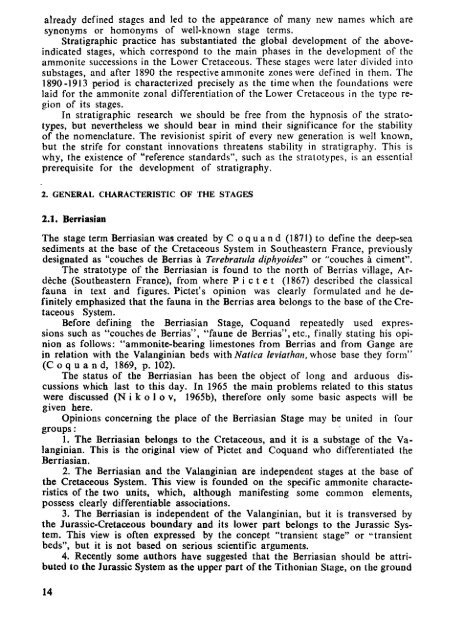THE MEDITERRANEAN LOWER CRETACEOUS
THE MEDITERRANEAN LOWER CRETACEOUS
THE MEDITERRANEAN LOWER CRETACEOUS
You also want an ePaper? Increase the reach of your titles
YUMPU automatically turns print PDFs into web optimized ePapers that Google loves.
already defined stages and led to the appearance of many new names which are<br />
synonyms or homonyms of well-known stage terms.<br />
Stratigraphie practice has substantiated the global development of the aboveindicated<br />
stages, which correspond to the main phases in the development of the<br />
ammonite successions in the Lower Cretaceous. These stages were later divided into<br />
substages, and after 1890 the respective ammonite zones were defined in them. The<br />
1890-1913 period is characterized precisely as the time when the foundations were<br />
laid for the ammonite zonal differentiation of the Lower Cretaceous in the type region<br />
of its stages.<br />
In stratigraphie research we should be free from the hypnosis of the stratotypes,<br />
but nevertheless we should bear in mind their significance for the stability<br />
of the nomenclature. The revisionist spirit of every new generation is well known,<br />
but the strife for constant innovations threatens stability in stratigraphy. This is<br />
why, the existence of "reference standards", such as the stratotypes, is an essential<br />
prerequisite for the development of stratigraphy.<br />
2. GENERAL CHARACTERISTIC OF <strong>THE</strong> STAGES<br />
2.1. Berriasian<br />
The stage term Berriasian was created by С oquand (1871) to define the deep-sea<br />
sediments at the base of the Cretaceous System in Southeastern France, previously<br />
designated as "couches de Berrias à Terebratula diphyoides" or "couches à ciment".<br />
The stratotype of the Berriasian is found to the north of Berrias village, Ardèche<br />
(Southeastern France), from where P i с t e t (1867) described the classical<br />
fauna in text and figures. Pictet's opinion was clearly formulated and he definitely<br />
emphasized that the fauna in the Berrias area belongs to the base of the Cretaceous<br />
System.<br />
Before defining the Berriasian Stage, Coquand repeatedly used expressions<br />
such as "couches de Berrias", "faune de Berrias", etc., finally stating his opinion<br />
as follows: "ammonite-bearing limestones from Berrias and from Gange are<br />
in relation with the Valanginian beds with Natica leviathan, whose base they form"<br />
(Coquand, 1869, p. 102).<br />
The status of the Berriasian has been the object of long and arduous discussions<br />
which last to this day. In 1965 the main problems related to this status<br />
were discussed (Nikolov, 1965b), therefore only some basic aspects will be<br />
given here.<br />
Opinions concerning the place of the Berriasian Stage may be united in four<br />
groups :<br />
1. The Berriasian belongs to the Cretaceous, and it is a substage of the Valanginian.<br />
This is the original view of Pictet and Coquand who differentiated the<br />
Berriasian.<br />
2. The Berriasian and the Valanginian are independent stages at the base of<br />
the Cretaceous System. This view is founded on the specific ammonite characteristics<br />
of the two units, which, although manifesting some common elements,<br />
possess clearly differentiable associations.<br />
3. The Berriasian is independent of the Valanginian, but it is transversed by<br />
the Jurassic-Cretaceous boundary and its lower part belongs to the Jurassic System.<br />
This view is often expressed by the concept "transient stage" or "transient<br />
beds", but it is not based on serious scientific arguments.<br />
4. Recently some authors have suggested that the Berriasian should be attributed<br />
to the Jurassic System as the upper part of the Tithonian Stage, on the ground<br />
14

















